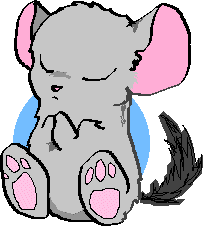Sponsored by BoysStuff.co.uk

The History of Chinchillas
Written by the Dungeon Master

So what is a Chinchilla? Well most folks around where we live have either not heard of them or thought it was a Mexican food dish! We have a lovely family of no less than seven of these adorable little pets. However little did those folks know that Mexico was closest to their home environment? Close, but not close enough. Chinchillas originate from high in the Andes Mountains in South America. Bye the way a Chinchilla looks like a cross between a squirrel and a chipmunk, kinda cute hey?
So what are they? The Chinchilla (Lat.Lanigera) is a small rodent and although until recent years it was practically unknown in Europe. There is however evidence that Chinchillas have existed since the earliest beginnings of history. Chinchillas in the wild state were very abundant in the parts of the Andes Mountains which are in Peru, Bolivia, Chile and Argentina. Even before the Americas were discovered, the Incas who lived in these regions used the pelts of these rodents, valuing their softness, warmth and lightness.
Although it is probable that some Chinchilla pelts made their way to Europe
in the Spanish galleons which took so many treasures from the New World to the
Old, there is little evidence of Chinchilla fur being used until the 18th century.
It then became a highly sort after fur and its popularity grew until the close
of the 19th century. In the year of 1899 many thousands of pelts where exported
annually from those countries where the Chinchillas lived.
So intensive was the trapping of the animals that they were in danger of becoming
extinct, and the pelts became more and more scarce. As this happened the value
of the furs increased, and a garment made of Chinchilla pelts could only be
brought by the very wealthy. Please bear in mind that over one hundred pelts
are required just to make one fur coat! An effort was made to conserve and increase
the very few wild Chinchillas that where left, and it become illegal to hunt,
trap or kill them. By this time there were so few left that trapping them for
pelts was no longer profitable.
So farms or ranches were set up in South America for the breeding of Chinchillas,
both to preserve the animals and to establish enough of them to ensure a supply
of pelts. Trappers were allowed to catch the animals as long as they were not
hot harmed in any way. They where then allowed to be properly kept and breed
in captivity. Most of the trapping was done by Indians, who were used to the
climatic conditions in which the Chinchillas lived, and could hunt them in the
high altitudes without undue hardship.
In 1922, an American, Mr. M. F. Chapman, who was a mining engineer, was given
permission to take some Chinchillas to America with him. There were several
problems to be overcome before this could be done. Permission to take the animals
out of South America was difficult to obtain, and once it was finally given
there was the question of whether the Chinchillas would survive a sea journey
which meant crossing the equator, coming as they did from so high up in the
Andes Mountains.
The fact that they survived not only the change of the climate and the long
sea journey, but also what must have been a complete change of diet, says much
for the hardiness of these adorable little animals. Only one died on the trip
and one of the females gave birth to a new Kit. (New born Chinchillas are called
Kittens or Kit for short) so the loss was made good.
From this tiny batch of three females and eight males was built up a thriving
community which grew in Canada and America where there were many Chinchilla
ranches. By the start of the 20th century, fur breeders become interested in
Chinchilla breeding and there were a large number of Chinchillas being bred
there. Why was the fur from this small rodent so much in demand and very highly
prized? It was because it is one of the finest furs in the world, very fine
textured, soft and silky to the touch and very light in weight. It was these
qualities that made it so attractive to woman, because many otherwise beautiful
furs were so heavy to wear and bulky in look when made up.
Another reason was that of the colour of the Chinchilla fur is so lovely and
cannot be imitated by dyeing as some other furs can. The colour ranges from
a beautiful bluish-grey to deep almost violet slate-blue. It was this colour
that provided the Chinchilla with an excellent camouflage in its natural habitat.
It rendered it inconspicuous among the blue-grey rocks of the Andes.
Fortunately as we approached modern days the popularity of fur garments declined due to many different factures. The introduction of man made nylon fur being one and pressure from various animal preservation groups, making the wearing of animal fur very unpopular. Whilst Chinchillas are still bred for their fur the cost and unpopularity of garments I am pleased to say is on the decline. Chinchillas are now being bred for pets and while this continues this dear little rodent will become better known and its popularity will increase.
In my next article I will discuss how to keep and bred them as pets. So, until
then. Chin Chin.

| © RIYAN Productions |

